Sharks of the Brazilian Coast
Sharks are among the oldest animals on Earth, having existed since the early Devonian period, about 400 million years ago. They are 100 times older than man and appeared about 150 million years before the first dinosaurs.
Although they are considered to be large and strong predators, they do not have a single bone in their body except for the jaw. Their skeletons are made entirely of cartilage, a much lighter and more flexible material than bone, which increased their speed and agility.
Today, there are about 365 species of sharks of all shapes and sizes. Some, like the whale shark, are among the largest fish in the world, while others are small enough to fit in the palm of your hand. With so much diversity, each has found its own way to live, avoiding competition for the same food.
In Brazil, between 80 and 90 species have been identified along the entire coast. Of these, 37 are in various stages of extinction or considered regionally extinct in Brazil. Some of the most fascinating species, with the most diverse lifestyles, are part of our fauna.
Bull shark (Carcharhinus leucas)
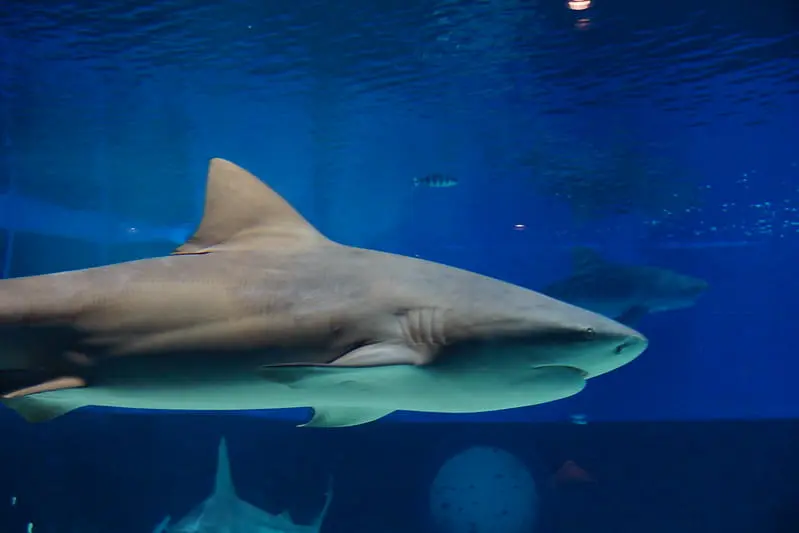
Bull sharks are about 3 meters (10 feet) long and are found near the coast throughout Brazil, especially in the north and northeast. They have the ability to tolerate fresh water for a period of time, with several known records of their occurrence along the Amazon River, including a specimen found in the Peruvian Amazon, about 3000 km (2000 miles) above the mouth of the river.
It feeds on fish, including smaller sharks (including its own species), rays , and birds that land or dive in the water. There are also records of predation on terrestrial animals in rivers. Although accidents are very rare, it is one of the main species to attack humans.
Although not comparable in size to the famous white shark, the bite of the bull shark is the most powerful of all sharks. The bite of the white shark can reach 950 N, and the bite of the bull shark is around 600 N. So although the absolute numbers are greater for the white shark, relative to its own body size, the bull shark is stronger.
Hammerhead sharks (Sphyrna spp.)
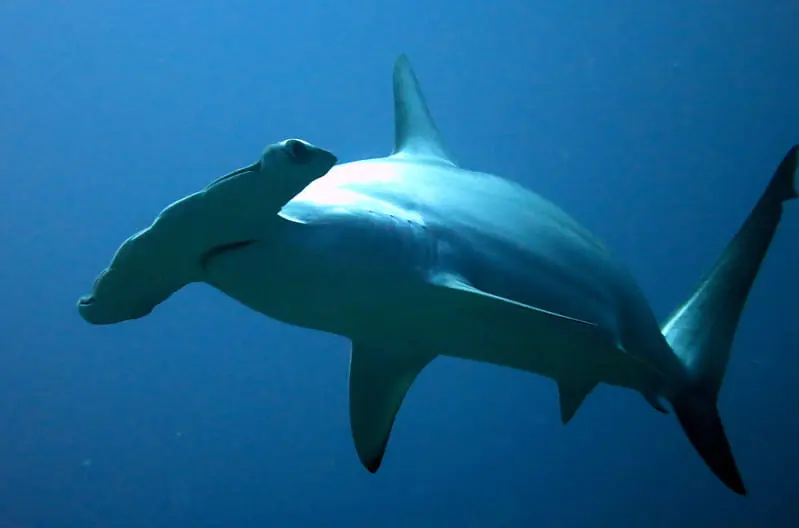
Of the eight hammerhead shark species, six are found in Brazil along the entire coast. The smallest of these (S. tudes) is about 1 m (3ft) and the largest (S. mokarran) is generally about 4.5 m (9 ft). However, the largest hammerhead shark ever recorded was 6.1 m (20 ft) long.
It is not clear why its head is shaped like this - one hypothesis is that the hammerhead shape provides more stability when swimming, as hammerheads do not have as good a sense of balance as other sharks. Another theory is that the shape allows the head to rotate more quickly.
Like other sharks, hammerheads can detect changes in temperature, salinity, electrical currents through very low magnetic fields, and even the heartbeat of small fish. However, a hammerhead’s ability to detect an electromagnetic pulse in the water is 10 times greater than other species.
Another interesting fact about these sharks has recently been discovered: the bonnethead or shovelhead (S. tiburo) is the only omnivorous shark, with more than 50 percent of its diet consisting of sea-grass. However, researchers have yet to reach a consensus as to why. While some say it is an accidental ingestion, others claim that because of the large quantity, such ingestion is purposeful, perhaps done to protect their stomachs from the spiny shells of the blue crabs they ingest.
Although solitary at night, juvenile hammerheads can form groups of up to 100 individuals during the day. Groups of adult sharks are usually smaller.
Their fins are extremely valuable on the Asian market for making soup, and due to large-scale fishing has made them one of the most endangered sharks: the population in 2003 was only 10% of what was estimated in 1986, the year they were first recorded.
Megamouth shark (Megachasma pelagios)
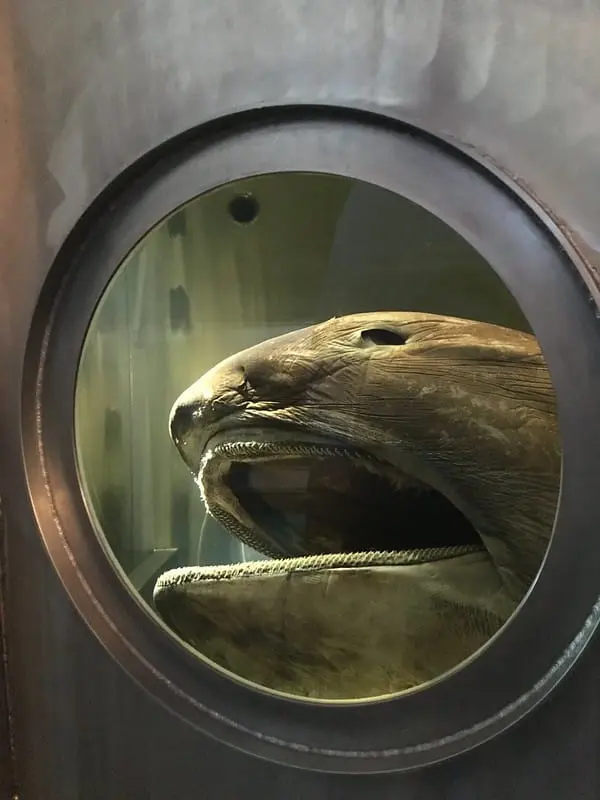
It is a deep-water species with extremely rare sightings, so it is not well known. Since its discovery in 1976, only 68 individuals have been caught or sighted as of 2015. There are only two records of this shark in the Atlantic Ocean, one in Senegal and another in the state of Santa Catarina in 1995. Despite its large size — the largest recorded to date being 5.5 m (16 ft), its swimming speed is surprisingly slow, reaching only about 2 km/h (1 mph).
Like the peregrine shark and the whale shark, it feeds by filtering plankton and jellyfish while swimming with its large open mouth. Around it are photophores — luminous organs that are probably used to attract their prey.
Whale shark (Rhincodon typus)
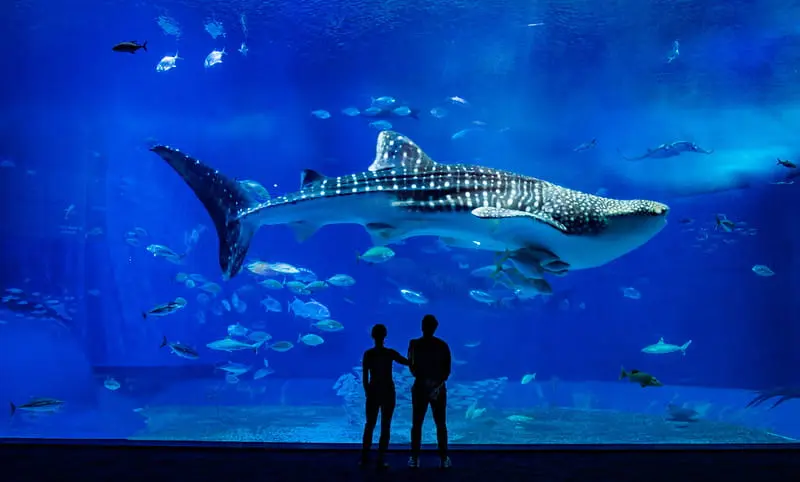
The whale shark is the largest fish in the world and one of the largest animals, second only to some species of cetaceans. It grows to about 10 m (33 ft) in length, but individuals over 20 m (65 ft) have been reported. Not only that, but its skin can be up to 15 cm (6 inches) thick.
A whale shark’s mouth is about 1.5 m (5 ft) wide and has about 350 rows of small teeth used to filter its food - plankton and small invertebrates that can be easily sucked up. When the plankton is sucked out, the water leaks out through the gills and the food is trapped inside (the same process happens with the megamouth and basking shark). A juvenile whale shark must consume approximately 20 kg (44 lbs) of plankton per day.
They usually swim in the open ocean, but at certain times of the year they will move closer to shore in search of more plankton. They are generally docile and are not a threat to humans, but due to their massive size, accidents can happen - so divers are advised not to get too close.
There is currently no population estimate, but the species is considered “vulnerable” due to the impacts caused by boats, fishing, and slow reproduction.
Basking shark (Cetorhinus maximus)
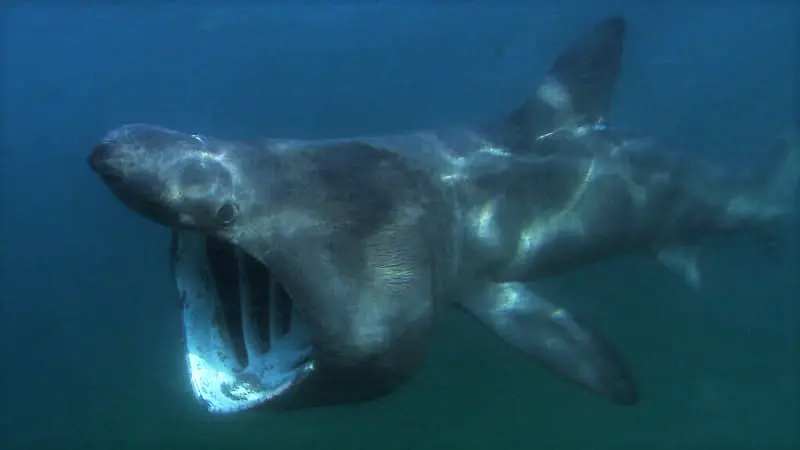
It is the second largest known fish, smaller only than the whale shark. It is usually 5 m (16 ft) long, but individuals have been reported to be over 10 m (33 ft) long and weigh over 4 tons. Despite its large size and mouth width of up to 1 m (3 ft), this shark feeds exclusively on plankton. Unlike megamouths and whale sharks, basking sharks do not actively forage for food, but simply swim slowly with their mouths open, waiting for plankton to filter through their gills.
Basking sharks spend about 90% of their time in deep water and only 10% at the surface, but can often be seen off the coast of southern and southeastern Brazil, where the water contains more plankton. Despite this, these sharks are not interested or bothered by the presence of humans.
Although they are generally solitary, many sharks gather at certain seasons to mate, avoid predators, or feed. Between 1980 and 2013, there were ten sightings of these sharks in large groups. In 2013, however, a group of nearly 1,400 individuals was seen in southern New England in the northeastern United States.
Despite these numbers, the basking shark, like many other sharks, is endangered due to overhunting in the 20th century. Today, its capture is prohibited in several countries.
We often see movies about how dangerous sharks are, but we can see that not all sharks are like that. Also, no shark attacks humans for food, as we are not part of their natural diet. In fact, most sharks don’t have very good eyesight and orient themselves mainly by detecting electrical impulses generated by movement, which makes the movement of humans in the water resemble that of animals that are part of their diet, for example, to a shark, surfers swimming on their boards can resemble seals when seen from below.
Among the more than 80 species of sharks found off the Brazilian coast, only three are considered dangerous to humans. In 23 years, there have been 75 shark attacks in Brazil, mainly in Pernambuco, most of which were not fatal. Furthermore, it is much more probable to be struck by lightning than to be attacked by a shark, which shows how exaggerated the bad press is that we give them.
Read more:
Dos tubarossauros aos modernos tubarões: História evolutiva
Genetic diversity and connectivity of the megamouth shark (Megachasma pelagios)
Tubarão touro tem a mordida mais forte entre os tubarões, diz estudo
Seagrass digestion by a notorious ‘carnivore’
Fact Sheet: Scalloped Hammerhead Shark
